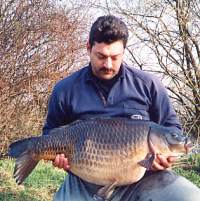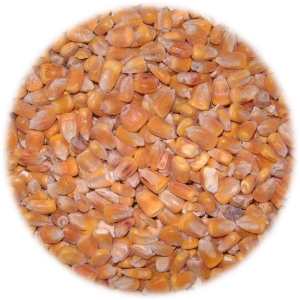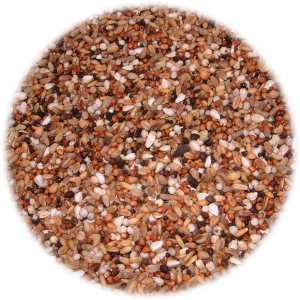|
|
| |
Rik started fishing at the age of four on his local tiny tidal river, catching eels and small wild trout on worm.
Not having had any angling family members, all his early fishing was solitary and this seems to have carried through to the present.
Like most anglers nowadays, he has a full time job, so his fishing time is limited.
He currently lives in the depths of Hampshire, and so is within easy reach of some excellent venues.
He has in the past, and still does, fish for most species, although his greatest love is for carp fishing, which is how the majority of his time is spent.
He now finds himself more thrilled with overcoming the intricacies and problems associated with catching carp, rather than the actual weight of the fish he catches and the so-called glory that goes with it.
Popular Particles
Many features have been written in the past by people who don’tactually use the baits they’ve written about, but in this article Iwill only cover the preparation and usage of particles I’ve used withany degree of success.
What do we mean when we use the term particle?
Most people would reason that this covers hemp and some nuts, butmy definition would be ‘a uniform bait that, when applied inquantities, will pre-occupy the fish’.
|
|
| |
A carp will feed most often and less cautiously over a naturalfood source, and particles resemble these. Because of theirrelatively small size, the carp will feed more avidly over particlesand any amount of avarice on the part of the carp will lead to lesscaution, resulting in a greater chance of it making a mistake.
At this juncture, I could provide a massive list of baits thatwould fit this bill, but instead, I will detail just a few that Ifeel are exceptional and are worthy of future consideration. I willalso not include pellets into this article, as I feel that theydeserve their own piece.
Hemp
Hemp needs no introduction and has been a spectacular bait formany years. Its success is, I believe, down to a few contributoryfactors.
|
|
| |
Firstly these lovely little seeds leak out the most amazingamounts of oil and secondly they mimic the tiny freshwater snails,which are so prevalent in, many gravel pits. This is why hemp willcontinue to be a brilliant bait.
The way I prepare and cook my hemp is fairly simple. Firstly, Igive it a rinse off with cold water, this removes most of the dirtand dust that seems to accumulate in the sack. I then cover the hempin cold water, stir in a generous quantity of sugar and then leave itto soak for 2 or 3 days. I’m not sure if the sugar does any good, butit does not harm it and it gives me confidence, so I’m happy tocontinue using it.
After the soaking stage, I then boil it up until approximatelyhalf the grains have split open and then I leave it to coolnaturally. Always ensure there is enough water covering the baitduring all the stages to enable the bait to be prepared correctly.The hemp is now ready to use.
Maize
You will have noticed my reference to maize in previous articles.It is an outstanding bait, which is massively underused in thiscountry. Carpers will not think twice about taking a massive amountto France but will shy away from it when they return to these shores.WHY?
|
|
| |
It is stupidly cheap, easy to prepare, it’s relatively dense, andso can be ‘pulted a fair distance. It’s resilient to smaller fish andis tough enough to be hair-rigged. It also takes colour and flavourwell at the soaking stage.
I prepare maize by firstly washing the grains clean of any dust. Ithen leave them to soak for 48 to 72 hours in cold water. To thiswater I may add flavour or colourings as required, good flavouringsare scopex, molasses, honey and salt. After the soaking stage, I boilthe bait for approximately 20 minutes and then allow it to cool.
Always make sure that there is enough water covering the bait, asit still soaks up water as it is cooling.
Maples
These are another very underused particle that were popular in thelate 70’s and early 80’s. Preparation is exactly the same as maize,although best flavours have been Hutchies Maplecreme and RegularSense Appeal.
I have had a lot of success in the warmer months fishing overlarge beds of maples, although I’ve never caught any carp using themas hookbait. (Plenty of tench though). All my catches have been byeither fishing a boilie or a tiger nut over them.
Unlike maize, which I have used successfully with both lightscatterings and heavy concentrations, all my maple fishing successhas been over very large beds. Having used up to 5 gallons of maplesin one night before, and caught continuously, I have no qualms at allabout using massive amounts of them.
Pigeon Conditioner
|
|
| |
PG or Red Band is a mixture of small seeds and pellet with a verystrong aniseed smell. It was originally designed and distributed byHaiths of Cleethorpes, although other manufacturers and importers nowsell an equivalent.
This bait is very easy to prepare, although I still give it awash-off. All that is required is to cover the bait in boiling waterand leave it for about an hour.
This is a very widely used bait and I feel its effectiveness isstarting to tail off where it is used extensively, but if you are oneof the first to use it on your water, then the catches over it can befantastic.
Chick Peas
Chickpeas are not used that extensively anymore. If you requireflavourings and colouring then the dried versions can be prepared asper maize, but I’ve had the most success with the ready preparedcanned varieties. They are too delicate to power cast any distance,but as a stalking bait or for close in work, then they really aresuperb and are instantly acceptable with no pre-baiting required.
Tigers
Tiger nuts really need no introduction and have been a brilliantcarp catcher for many years. They are also one of the few particles,along with hemp, that I have absolute faith in during the winter.
For the preparation of tigers, I usually soak them for 3 or 4 daysin cold water with a large helping of sugar. I then boil this lot forabout 20 or 30 minutes. Tigers will not soften too much aftercooking, so don’t think that they’re not cooked. I transfer thecooked baits and fluid to a bucket and usually leave them for about 2or 3 days before using or freezing them.
Leaving them for this extra couple of days makes all the juices gothick and syrupy (aided by the sugars) and this massively adds to theattraction.
I hope this has given you an insight into the particles Icurrently use and as always, if you have any questions or queriesregarding this or any other matter, then you can contact me atcarp.angler@talk21.com















